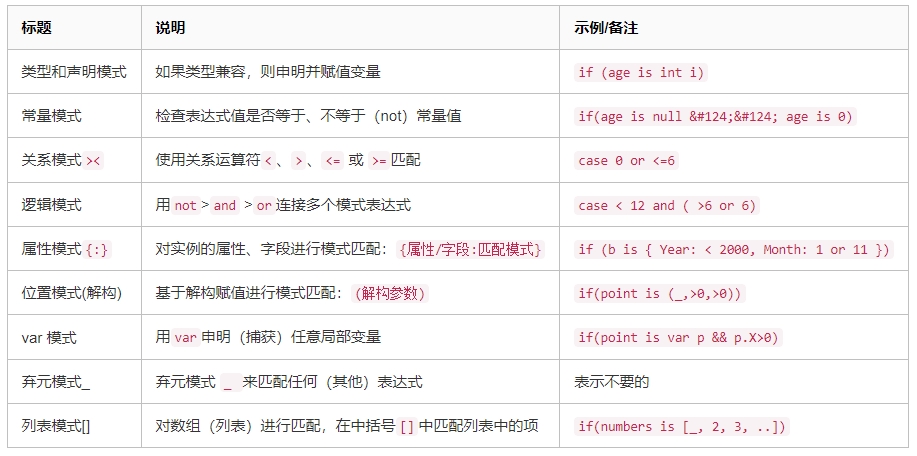C#模式匹配汇总
模式匹配概述
C# 支持多种模式,包括声明、类型、常量、关系、属性、列表、var 和弃元等,在is、switch语句、switch表达式中使用,还可以使用布尔逻辑关键字 and、or 和 not 组合多个模式,极大的简化了代码编写,可读性也还不错。

模式匹配详解
类型和声明模式
检查类型是否匹配,同时申明变量,如果类型兼容则申明并赋值变量,该变量在后面代码作用域中有效。
object age = "123";
if (age is int i) //类型匹配+申明变量i
{
Console.WriteLine($"age1 = {i}");
}
switch (age)
{
case string: //类型匹配
Console.WriteLine($"type is string");
break;
case int iage: //类型匹配+申明变量iage
Console.WriteLine($"age2 = {iage}");
break;
}
//上面is语句编译后的代码效果:
if (obj is int)
{
int value = (int)obj;
}常量模式
检查表达式值是否等于、不等于(not)常量值,常量值包括字面量常量,也包括const常量值。传统的Switch语句就是常量模式匹配。
object age = null;
if (age is not null && age is 100) //age is 100 等同于 age is int && (int)age==100
{
Console.WriteLine($"age1 = {age}");
}
var type = age switch{
1 or 2 or 3=>"婴儿", // 关系模式,关系模式
4 => "幼儿", // 常量模式
null or not 5 => "unknow", // 关系模式,关系模式
_=>"", // 弃元模式
};关系模式><
用关系运算符来匹配表达式,就是对常量数值进行大小比较运算,使用关系运算符<、>、<= 或 >=,多个表达式可用and、or连接,当然也支持括号。
object age = 6;
if (age is int n and >= 6)
{
Console.WriteLine("666");
}
switch (age)
{
case 0 or <=6:
Console.WriteLine("幼儿");
break;
case < 12 and ( >6 or 6):
Console.WriteLine("青少年");
break;
}逻辑模式not/and/or
用 not、and 和 or 模式连结符来创建逻辑模式,连接多个模式表达式。
- 优先级顺序:
not>and >or。 - 推荐使用(括号)显示控制优先顺序,可读性更好。
object age = 6;
if (age is int n and (not 6 or >5) )
{
Console.WriteLine("666");
}属性模式{:}
对实例的属性、字段进行模式匹配,可以嵌套其他模式匹配,非常的强大,属性匹配用大括号来包装{属性/字段:匹配模式}。
- 多个属性/字段都匹配为
true时,最终才会匹配成功。 - 可以结合类型申明模式使用。
- 可嵌套使用,会递归匹配。
DateTime birthday = new DateTime(1999, 11, 12);
if (birthday is { Year: < 2000, Month: 1 or 11 })
{
Console.WriteLine("年龄、星座不合适");
}
//嵌套使用
public record Point(int X, int Y);
public record Segment(Point Start, Point End);
static bool IsAnyEndOnXAxis(Segment segment) =>
segment is { Start: { Y: 0 } } or { End: { Y: 0 } };
static bool IsAnyEndOnXAxis(Segment segment) =>
segment is { Start.Y: 0 } or { End.Y: 0 };位置模式(解构)
基于解构赋值进行模式匹配:
- Tuple、record 和 DictionaryEntry是内置支持解构的,关于解构赋值可参考相关内容。
- 用括号
()报装,这也是 解构(Deconstruct)的语法形式。 - 可以嵌套其他模式匹配,如常量、关系、逻辑、属性模式等。
void Main()
{
Point point = new Point("sam", 12, 13);
var len = point switch
{
//类型匹配、属性模式、位置模式:Name属性必须为string,且长度为0,X、Y值为0
(string { Length: <= 0 }, 0, 0) => 0,
(_, > 0, 0) => point.X, //X值大于0,Y值为0
(_, 0, > 0) => point.Y, //Y值大于0,X值为0
(_, 10 or > 10, 10 or > 10) p => p.X * p.Y,
_ => 0,
};
}
public record Point(string Name, int X, int Y);var 模式
用var申明(捕获)任意局部变量,把表达式的结果分配给var临时变量。算是类型模式的变种,将类型名替换成了var。
void Main()
{
Point point = new Point("sam", 12, 13);
if(point is var p && p.X>0 && p.Y>0){ //is var
Console.WriteLine("OK");
}
var len = point switch
{
var (_,x,y) when x>0 && y>0 => true,// var
};
}
public record Point(string Name, int X, int Y);弃元模式_
弃元模式(Discard Pattern),字面理解就是被遗弃、没人要的。可以将弃元模式看做是一个占位符,表示一个没人用的变量,可匹配任意类型,用来简化代码。语法是用下划线“_”表示。
常用场景:
- 解构时的占位符。
- 在Switch中匹配任意其他模式,类似default的作用。
- 在out参数中占位,表示一个没人用的out参数。
- 独立弃元,接收无用的表达式输出。
var tuple = new Tuple<int, int>(3, 4);
var (x, _) = tuple; //1、只需要第一个参数,其他就用“_”来占位
Console.WriteLine(x); //3
_= x switch
{
2 or <2 => "small",
int and <18=>"young",
_=>"other", //2、匹配其他模式,效果同default
};
int.TryParse("", out _); //3、不用的out变量,实际上是申明了变量的
async void Print(object arg)
{
_ = arg ?? throw new ArgumentException(); //4、接收无用的返回,效果同下
if (arg == null) throw new ArgumentException();
_ = Task.Run(()=>Console.WriteLine("task run")); //接收一个不用的返回
}列表模式[]
C#11支持的,对数组(列表)进行匹配,在中括号[]中匹配列表中的项。
- 跳过的项可以用弃元模式_。
- 可以用数组的切片模式匹配开头、结尾的元素。
void Main()
{
int[] numbers = { 1, 2, 3, 4 };
Console.WriteLine(numbers is [_, 2, 3, ..]); // True
Console.WriteLine(numbers is [0 or 1, <= 2, >= 3]); // False
}模式匹配应用
模式匹配主要就用在 is 运算符、switch 语句、switch 表达式中。
is运算符
is运算符本来主要是用来检测类型兼容性的,加上模式匹配就能玩出各种花样了,极大简化了让各种检查类的代码。
object value = 12;
if (value is int && value is not null) //is类型检测+逻辑模式
{
Console.WriteLine(value);
}
if (value is int a && a > 6) //+申明模式
{
Console.WriteLine(a);
}
if (value is int age and > 10 and < 14) //关系模式
{
Console.WriteLine(age);
}
var user = new { Name = "sam", Age = 12 };
if (user is { Name: _, Age: > 10 }) //属性模式
{
Console.WriteLine(user.Name);
}
int[] arr = new int[] { 1, 2, 3 };
if (arr is [> 0, ..]) //列表模式:第一个元素>0
{
Console.WriteLine(arr);
}
var dt = new Tuple<string, int>("sam", 100);
if (dt is (_, > 60) d) //位置模式+申明模式(好像没什么用)
{
Console.WriteLine(d.Item1);
}
switch..case语句
switch..case 语句 是很多语言中都有的基本多条件分支语句,传统的 case 只能用于匹配常量,多用于枚举。
case不能穿透,一个case执行完后必须break结束,或者return返回(退出方法),可以多个case匹配执行一组逻辑代码。- 传统的
case就是常量模式,而现代的case可以结合上面多种模式使用,非常强大。 - 加
when,自由附加更多条件。
int age = 22;
string sex = "Male";
switch (age)
{
case 1:
case 2:
Console.WriteLine("婴儿");
break;
case <= 3:
Console.WriteLine("幼儿");
break;
case > 10 and < 16:
Console.WriteLine("青少年");
break;
case > 18 when sex == "Male":
Console.WriteLine("成年男性");
break;
case int:
break;
}switch表达式
C#8中switch有了新的语法 —— switch 表达式 ,可以看做是switch..case语句的一个变种,使用比较类似。switch表达式是一个赋值(输出)语句。
=>左侧为模式(返回一个bool),如果模式匹配(true)则返回右侧的值,最后一个弃元模式匹配其他情况,同default效果。
// 常规使用
int type = 6;
var message = type switch
{
<= 1 => "success",
2 => "warning",
3 => "error",
> 3 and < 10 => "other error",
_ => "unkonwn error",
};
// 可以用when来进行更多的判断,when后面的表达式就很自由了,只要返回boo即可。
object type = 6;
var message = type switch
{
int i when i<6 => "ok",
string s when s=="null"=>"Null",
string s when !string.IsNullOrEmpty(s)=>"string value",
_=>"unknown value"
};
Console.WriteLine(message);
// 支持多个变量的组合模式:用括号()包含多个变量
string gender = "male";
int age = 10;
string type = (gender,age) switch{
("male",>18)=>"VIP",
(not "male",>26 and <35)=>"VVIP",
_=>"",
};
扩展阅读
模式匹配汇总
模式匹配 - 模式中的 is 和 switch 表达式,以及 and、or 和 not 运算符
最后更新于 2024-05-20 17:06:59 并被添加「」标签,已有 3979 位童鞋阅读过。
本站使用「署名 4.0 国际」创作共享协议,可自由转载、引用,但需署名作者且注明文章出处
此处评论已关闭